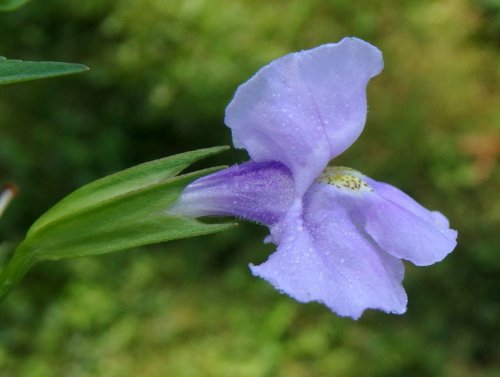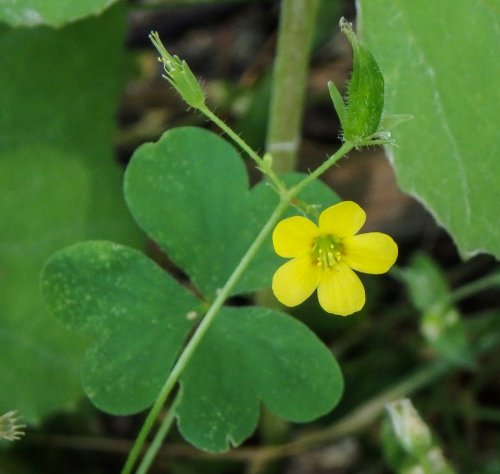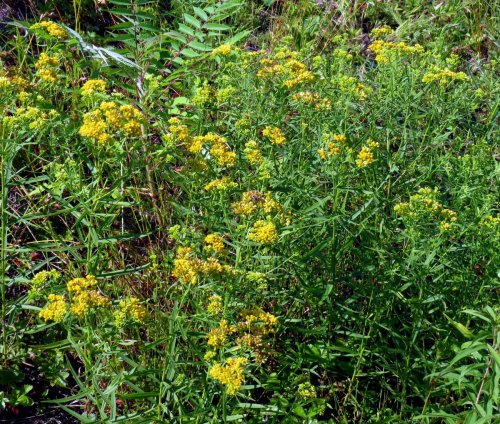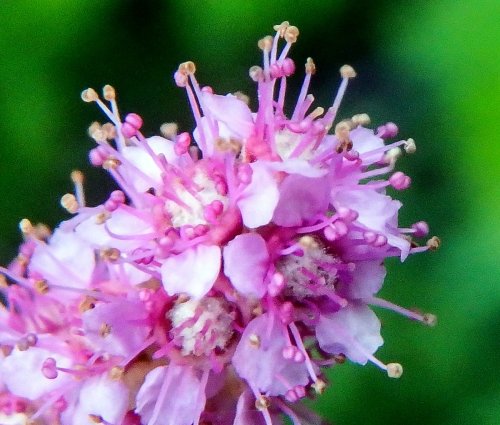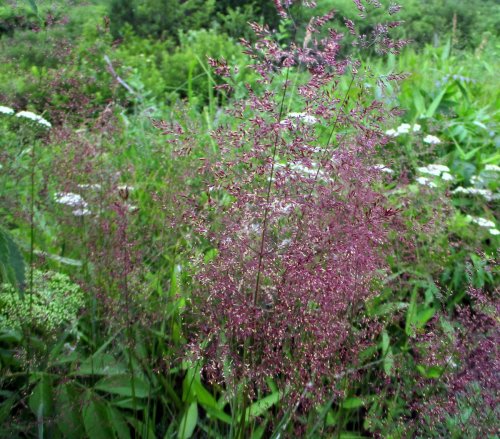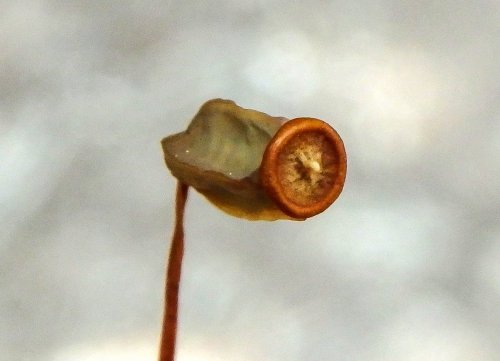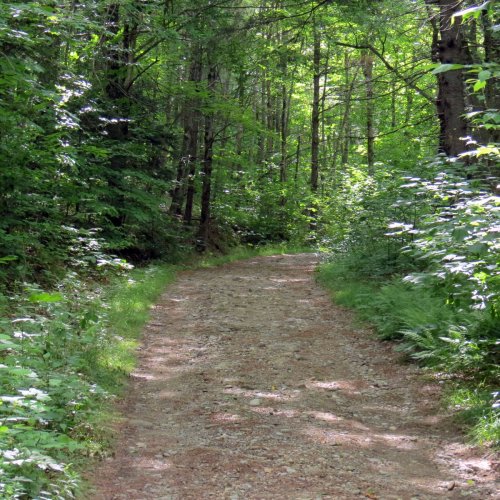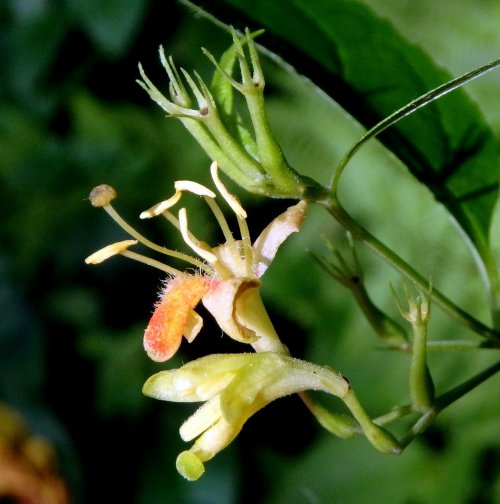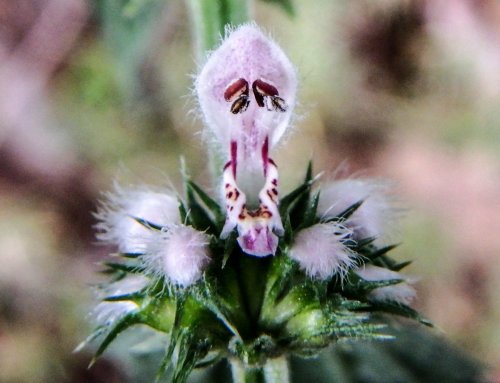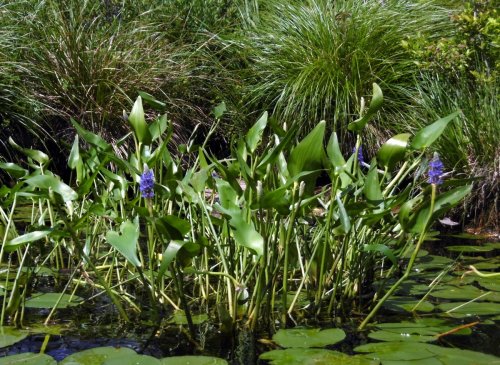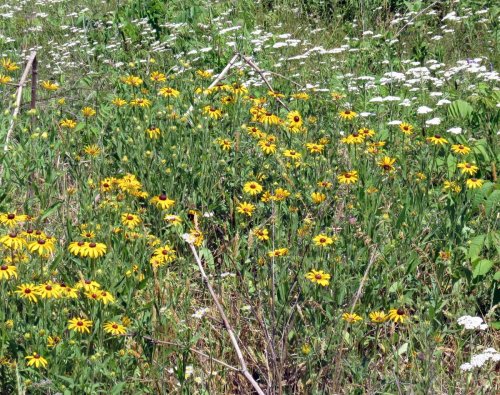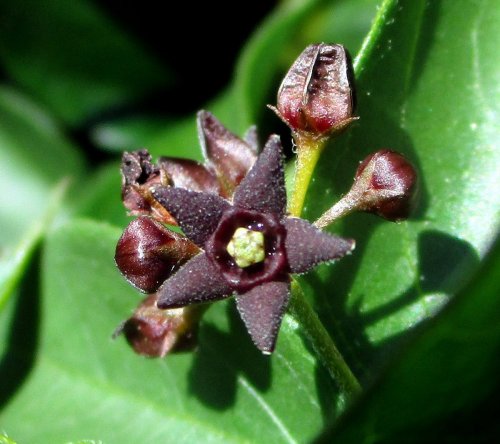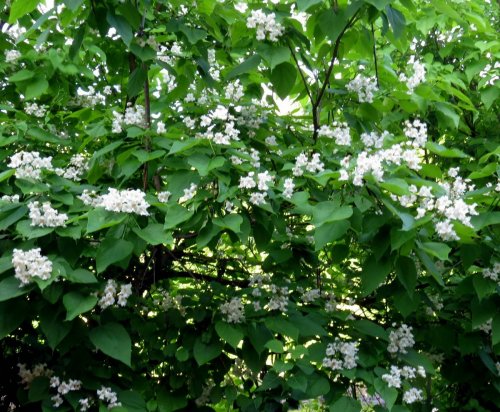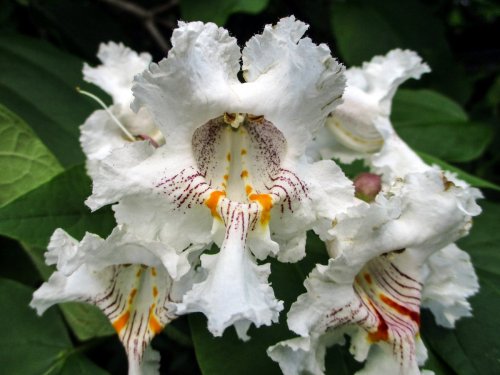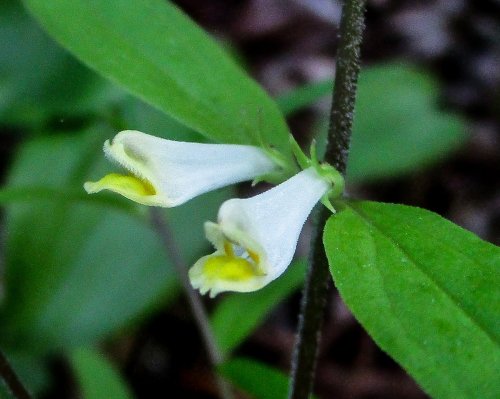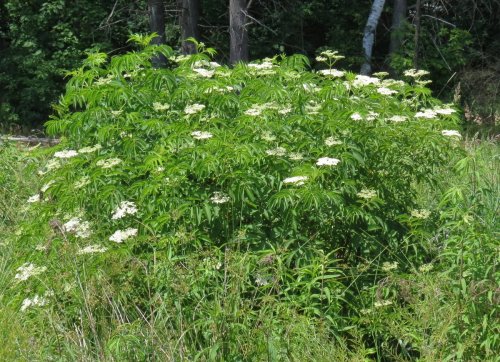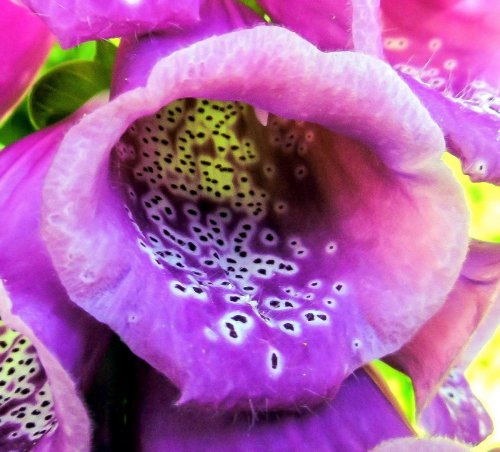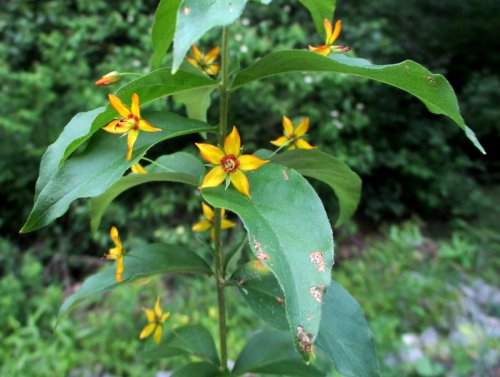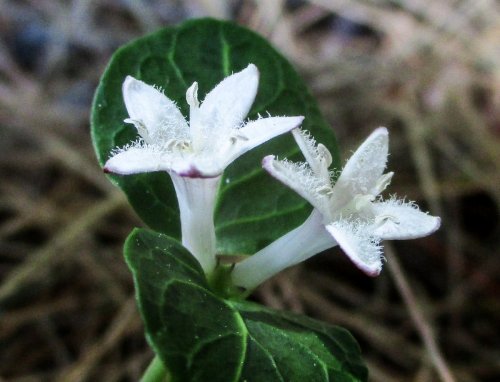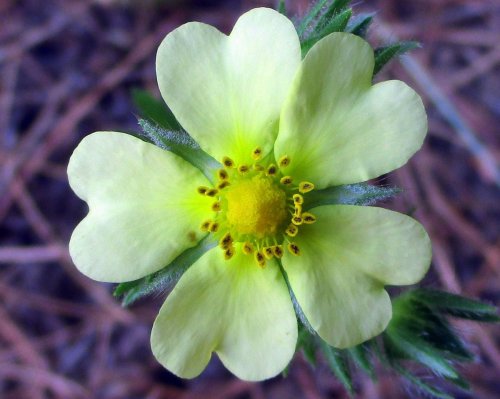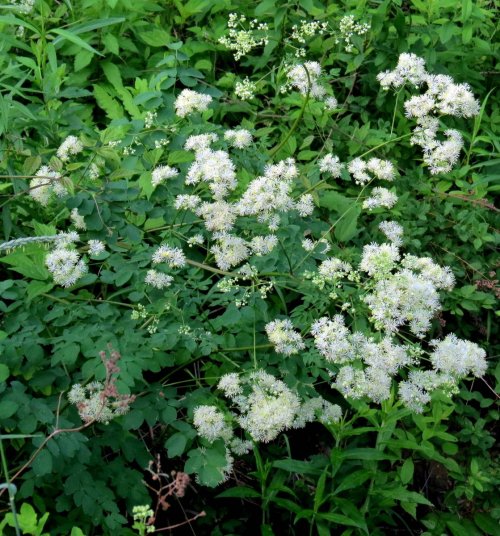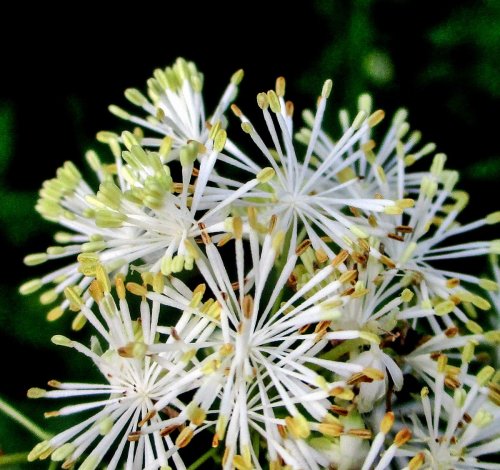Monkey see, monkey do, but I don’t see a monkey in you. Someone must have seen a smiling monkey’s face when they looked at this flower though, because that’s how the Allegheny monkey flower (Mimulus ringens) got its common name. This plant has a square stem and that’s how it comes by another common name: square stemmed monkey flower. It gets about knee high and likes to grow in wet, sunny places, and isn’t all that common. I know of only two places where it grows.
I’m still not seeing a monkey. All I see is a beautiful little flower that is whispering summer’s passing.
Northern bugleweed (Lycopus uniflorus) has opposite leaves that turn 90 degrees to the previous pair as they make their way up the square stem. Tufts of very small white flowers grow around the stem in the leaf axils. This plant likes wet places and, since there are many different species of Lycopus, it can be hard to identify. In fact, I’m never 100% sure that I’ve gotten it right.
The tiny flowers of northern bugleweed are about 1/8 inch long and tubular with 4 lobes, a light green calyx with 5 teeth, 2 purple tipped stamens, and a pistil. They are also very difficult to photograph because they’re so small. The plant is usually about knee high when I find it along the edges of ponds and streams. They often fall over and grow at an angle if there aren’t any other plants nearby to support them. Several Native American tribes used the tuberous roots of bugleweed as food.
Native common yellow wood sorrel (Oxalis stricta) is unusual because it grows in woods or meadows and I see it in both. It’s considered a weed by many and is largely ignored by most, but it’s a very interesting plant. Its raw leaves can be chewed as a thirst quencher if you forgot to bring water on your hike. The native American Kiowa tribe called it “salt weed” and used it that way for long walks. Its seed capsules can also be chewed but they can also explode when mature and can fling seeds up to 13 feet away. They are said to be tart with a flavor similar to rhubarb. The plant is high in vitamin C and it can be pressed to make a passable vinegar substitute.
Slender fragrant goldenrod (Solidago tenuifolia) is a goldenrod that’s easy to identify because of its long slender, willow like leaves and its pleasant, vanilla like fragrance that is impossible to describe. The only other similar goldenrod is the lance leaved goldenrod (Solidago graminifolia) but its leaves are wider and have 3 to 5 veins as opposed to the single vein in a slender fragrant goldenrod leaf. It is also called flat topped goldenrod.
Insects of all kinds swarm over slender fragrant goldenrod and you have to be careful that you aren’t going to inhale one when you smell it.
My grandmother taught me a lot about plants and the one she started with was one of our native wintergreens that she called checkerberry. I call it teaberry (Gaultheria procumbens) and if you’ve ever chewed Clark’s Teaberry Gum you know exactly what the plant’s small red berries taste like. The fragrance of the oil is unmistakable and can be recognized immediately in toothpaste, mouthwash, pain relievers, etc. Another name for it is American wintergreen. Its evergreen leaves were once chewed to relieve pain because they contain compounds similar to those found in aspirin, and anyone allergic to aspirin should leave it alone. As the photo shows teaberry’s blossoms look a lot like tiny blueberry blossoms. The plants are having a good year; I’ve never seen so many blossoms on teaberry plants.
Tansy (Tanacetum vulgare) is a European native that has been cultivated for centuries. The flat flower heads are made up of many button like disc flowers; almost like a daisy without the white ray flowers that we call petals. Tansy is a natural insect repellent and was used as such in colonial times. Dried tansy added to the straw in mattresses was said to keep bedbugs away. Most tansy plants are seen in gardens but it had naturalized itself in New England by 1785 and can still be occasionally found growing along roadsides. It’s a good plant to use in vegetable gardens for pest control. The ancient Greeks grew tansy for medicinal use but modern science has found it to be toxic.
I know of only one place to find field milkwort (Polygala sanguinea) and it is always worth the walk to see them. The flowers are very beautiful and unusual enough to make you want to sit beside them for a while and study them, and that’s just what I usually do.
On field milkwort flowers what look like petals arranged on a central stem are actually individual flowers packed into a raceme no bigger than the end of an average index finger. Each tiny overlapping flower has two large sepals, three small sepals, and three small petals that form a narrow tube. Several different kinds of bees help pollinate this plant. Its flowers can be white, purple, pink, or green and I’ve noticed that the color can vary considerably from plant to plant.
I’ve shown 2 or 3 small lobelias with blue / purple flowers over the past few flower posts and here is another one. This lobelia is called Indian tobacco (Lobelia inflata.) and the small flowers are about 1/3 of an inch long. It is the only lobelia with calyxes that inflate after the flowers have fallen and to identify it I just look for the inflated seedpods.
Indian tobacco gets its name from the way its inflated seed pods resemble the smoking material pouches that Native Americans carried. The inflata part of its scientific name also comes from these inflated pods. The pods form so quickly that they can usually be found on the lower part of the stem while the upper part is still flowering. Though Native Americans used this and other lobelias to treat asthma and other breathing difficulties they knew how to use what we don’t, and today the plants are considered toxic. They can make you very sick and too much can kill.
This purple coneflower (Echinacea purpurea) seems to have dressed in the dark and thrown on any old thing. Its petals were all different sizes and one or two seemed to be missing, but at least they were all the same color. If the butterflies and bees don’t mind then I don’t suppose I should either. Purple cone flower is known for its medicinal qualities as well as its beauty. According to the USDA the plant was used by many Native American tribes throughout North America to treat a variety of ailments. It was used as a pain reliever, anti-inflammatory, a treatment for toothaches, coughs, colds, and sore throats. It was also used as an antidote for various forms of poisonings, including snake bite. Portions of it were also used to dress wounds and treat infections. Modern medicine has found it useful to combat bacterial and viral infections and as an immune system booster. I grow it because butterflies and bees like its nectar, birds like the seeds, and I like to admire its beauty.
Broad leaved helleborine orchids (Epipactis helleborine) are originally from Europe and Asia and were first spotted in this country in Syracuse, New York in 1879. The plant has now spread to all but 19 of the lower 48 states and is considered an invasive weed. It doesn’t act very invasive here; I usually see only a few plants each year and every time I see them they’re growing in deep shade. I’ve never been able to find out how the plant comes by its common name. It seems a bit odd because it doesn’t seem to resemble either hellebore or false hellebore.
Scientists have discovered that the nectar of broad leaved helleborine contains the strongest narcotic compounds found in nature; comparable to oxycodone, and when insects (wasps) sip it they tend to stagger around for a while. This increases their chances of picking up the orchid’s pollinia, which are sticky little sacks of pollen that orchids produce instead of the dust-like pollen produced by many other flowers. Once the insect flies off it will most likely be oblivious to the pollen packets that it has stuck all over itself. By transporting its pollinia to another helleborine flower the insect will have repaid the intoxicating orchid for the buzz.
Steeple bush (Spirea tomentose) seems more herb than shrub to me but it’s in the spirea family of many shrubs. Sometimes it gets confused with meadowsweet (Spirea alba) but that plant is a very woody shrub with white flowers in flower heads that aren’t as long and pointed as these are. A dense coat of white wooly hairs covers the stem and the leaf undersides of steeple bush, and that’s where the tomentose part of the scientific name comes from. It means “covered with densely matted woolly hairs.” I almost always find this plant at the water’s edge.
Five petaled, pink steeplebush flowers are about 1/16 of an inch wide and loaded with 5 pistils and many stamens, which is what often gives flowers in the spirea family a fuzzy appearance. Many different butterflies love these flowers. Native Americans used the plant medicinally in much the same way that we would use aspirin.
The beautiful little flowers of red sandspurry (Spergularia rubra) are hard for me to see because they’re so small, so I take photos of them so I can see them better. This plant was originally introduced from Europe in the 1800s and it has reached many states on the east and west coasts but doesn’t appear in any state along the Mississippi river except Minnesota. It must have been introduced on both coasts rather than first appearing in New England and then crossing the country like so many other invasive plants have. I’m not sure where the red in the common name comes from. I wonder if the person who named it was colorblind.
If you truly love Nature, you will find beauty everywhere. ~Vincent Van Gogh
Thanks for stopping in.

